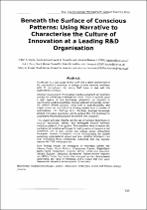 ResearchSpace
ResearchSpace
Beneath the surface of conscious patterns: using narrative to characterise the culture of innovation at a leading R&D organisation
JavaScript is disabled for your browser. Some features of this site may not work without it.
- ResearchSpace
- →
- Research Publications/Outputs
- →
- Book Chapters
- →
- View Item
| dc.contributor.author |
Maree, GA

|
|
| dc.contributor.author |
Roux, DJ

|
|
| dc.contributor.author |
Marais, Mario A

|
|
| dc.date.accessioned | 2007-07-27T09:50:15Z | |
| dc.date.available | 2007-07-27T09:50:15Z | |
| dc.date.issued | 2006-02 | |
| dc.identifier.citation | Maree, GA, Roux, DJ and Marais, MA. 2006. Beneath the surface of conscious patterns: using narrative to characterise the culture of innovation at a leading R&D organisation. Experiences in knowledge management: a portfolio of case studies,19p | en |
| dc.identifier.uri | http://hdl.handle.net/10204/1042 | |
| dc.description.abstract | The South African Council for Scientific and Industrial Research (CSIR) was founded in 1945 and knowledge has always been a core asset of the organisation and is a direct determinant of the organisation’s relevance. Strategic management of innovation is seen as both a social and a key business process for converting knowledge into value. Current reality is projects that typically entail a high degree of new knowledge generation as opposed to repackaging of existing knowledge. Human skills and knowledge are the primary limiting resource for an R&D organisation. Most work is multi-disciplinary in nature and project teams are assembled by drawing experts from a number of organisations. The challenge is to effectively leverage human skills or knowledge towards innovation excellence and to achieve this it is necessary to understand the prevailing culture associated with innovation. Narrative techniques are used to uncover behaviours, themes and archetypes beyond the everyday conscious patterns of recognition. An important area of impact is the change process currently underway at the CSIR. Here, the aim is to shift the CSIR back to a stronger R&D basis in line with the organisation’s mandate. Aspects include processes to understand the current underlying organisation values and culture and narrative can add value to these complexities. Outcomes from this exercise support the change process at the CSIR. The main objectives are to investigate or explore the usefulness of narrative techniques for making sense of complex social processes and; gain insights into the cultural issues surrounding innovation. | en |
| dc.language.iso | en | en |
| dc.subject | Narrative techniques | en |
| dc.subject | Change process | en |
| dc.subject | Archetypes | en |
| dc.subject | Innovation | en |
| dc.title | Beneath the surface of conscious patterns: using narrative to characterise the culture of innovation at a leading R&D organisation | en |
| dc.type | Book Chapter | en |
| dc.identifier.apacitation | Maree, G., Roux, D., & Marais, M. A. (2006). Beneath the surface of conscious patterns: Using narrative to characterise the culture of innovation at a leading R&D organisation., <i></i> http://hdl.handle.net/10204/1042 | en_ZA |
| dc.identifier.chicagocitation | Maree, GA, DJ Roux, and Mario A Marais. "Beneath the surface of conscious patterns: using narrative to characterise the culture of innovation at a leading R&D organisation" In <i></i>, n.p.: n.p. 2006. http://hdl.handle.net/10204/1042. | en_ZA |
| dc.identifier.vancouvercitation | Maree G, Roux D, Marais MA. Beneath the surface of conscious patterns: using narrative to characterise the culture of innovation at a leading R&D organisation. [place unknown]: [publisher unknown]; 2006. [cited yyyy month dd]. http://hdl.handle.net/10204/1042. | en_ZA |
| dc.identifier.ris | TY - Book Chapter AU - Maree, GA AU - Roux, DJ AU - Marais, Mario A AB - The South African Council for Scientific and Industrial Research (CSIR) was founded in 1945 and knowledge has always been a core asset of the organisation and is a direct determinant of the organisation’s relevance. Strategic management of innovation is seen as both a social and a key business process for converting knowledge into value. Current reality is projects that typically entail a high degree of new knowledge generation as opposed to repackaging of existing knowledge. Human skills and knowledge are the primary limiting resource for an R&D organisation. Most work is multi-disciplinary in nature and project teams are assembled by drawing experts from a number of organisations. The challenge is to effectively leverage human skills or knowledge towards innovation excellence and to achieve this it is necessary to understand the prevailing culture associated with innovation. Narrative techniques are used to uncover behaviours, themes and archetypes beyond the everyday conscious patterns of recognition. An important area of impact is the change process currently underway at the CSIR. Here, the aim is to shift the CSIR back to a stronger R&D basis in line with the organisation’s mandate. Aspects include processes to understand the current underlying organisation values and culture and narrative can add value to these complexities. Outcomes from this exercise support the change process at the CSIR. The main objectives are to investigate or explore the usefulness of narrative techniques for making sense of complex social processes and; gain insights into the cultural issues surrounding innovation. DA - 2006-02 DB - ResearchSpace DP - CSIR KW - Narrative techniques KW - Change process KW - Archetypes KW - Innovation LK - https://researchspace.csir.co.za PY - 2006 T1 - Beneath the surface of conscious patterns: using narrative to characterise the culture of innovation at a leading R&D organisation TI - Beneath the surface of conscious patterns: using narrative to characterise the culture of innovation at a leading R&D organisation UR - http://hdl.handle.net/10204/1042 ER - | en_ZA |





